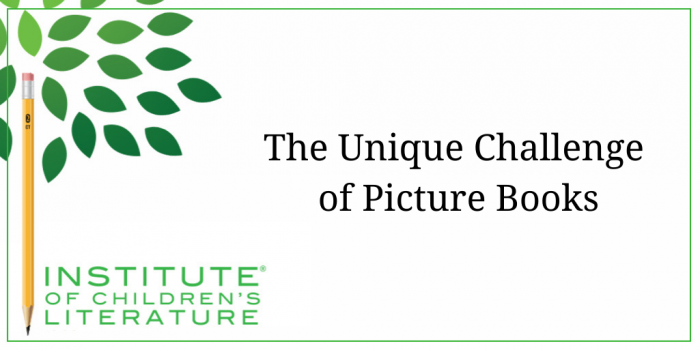1000 N. West Street #1200, Wilmington, DE 19801
© 2024 Direct Learning Systems, Inc. All rights reserved.

We teach our students how to write and get published!
View our Course Catalog >
As with many art forms and literary genre, the picture book has changed over time.
Picture books are a fairly young art form. The beginning of true picture books can probably be tracked to the life of Randolph Caldecott, around 130 years ago. Before that, illustrated stories for children were nearly all dense text with the illustrations predominantly there for visual interest, to help readers visualize some of the elements of the tale. But the illustrations weren’t meant to add to the story itself. The illustrator wasn’t meant to be a storyteller. The reader could hear the story read aloud and never see the pictures at all and the story would still be complete and full. In many ways, these old illustrated books are little more than short stories with extra pictures. In this, they share elements with illustrated stories in magazines today.
But Randolph Caldecott saw illustrations differently. He saw the opportunity for the pictures to replace words, to tell their own side of the story. Still, even extremely popular picture books like Curious George or Babar were still more story than picture. But the end of the 1950s and beyond saw the illustrators coming into their own as a storytelling partner. One of the great gems among picture books, Where The Wild Things Are by Maurice Sendak, tells the story in just 338 words of text (which should inspire all of us who flinch at the idea of writing a picture book with a plot and action in less than 600 words, as many publishers today prefer).
The main element of today’s picture book is shared storytelling. As a writer, we’re used to thinking of our words as the means by which a story is told. And this is true in novel writing and short story writing, but it is only half of the truth in picture books. The story that you write is only half of what the piece will become when an insightful publisher marries it to a skilled visual storyteller. The words you write are like the tightly closed buds of a rose bush. They are rich with potential, but unless they bloom, the full potential will never be reached, we’ll never see all that it is capable of. The storytelling of the illustrator brings that bloom to the final picture book. Your writing began it, but the manuscript text is far, far from the final creation.
What Can Words Do?
Because of this, the text portion of a publishable picture book today has room for the illustrator’s storytelling. It isn’t written like a short story. The manuscript you write will not try to do the illustrator’s job of showing the visuals of the story. That is the place of the visual storyteller. So what is the place of the writer? What do you provide? You provide all the things that illustrations cannot. You provide sensory detail that doesn’t rely on your sense of sight. For instance, you provide the sound: Bang! Splash! Boop-a-loop! An illustrator cannot make the reader hear. The illustrator cannot give the child the refrain to shout every time he or she hears the story. You do that. You do it by thinking about the sound you bring to the manuscript. Sound isn’t the only sensory input the text might bring. You can make the child smell the tangy sweetness of an orange or taste the crunchy snap of celery. You can coax the child into feeling the softness of a kitten’s fur or the prickle of a hedgehog. Your words can trigger sensory connections in the child that are beyond the illustrator’s bag of tricks.
You also provide the basic structure of the story. You show us the main character’s heart, and needs, and challenge. You set the character moving forward toward the goal. You send the child out into the garden in search of lions. Or let the child race around madly in an attempt to prove he is not sleepy, no, not a bit. Or send the child to the land of the wild things to escape the punishment of being sent to his room. You get the story going and your words must be open enough that there is room for the illustrator to make them even more. But it’s still your words that get the whole machine going.
Writing picture books today is not easy. They must sing. They must hoot, and boom, and whistle. They must make the reader gasp or giggle. And they must do it with so few words that you labor over each word as if it were a diamond to be delicately chipped into its most sparkling beauty.
Don’t choose picture books because you think they’re easy.
Jump in knowing it’s hard, but knowing also that it’s worth the struggle, because when you get it exactly right, you have the chance to create something that shapes generations. Something that is never forgotten. And that’s worth all the sweat and effort.
1000 N. West Street #1200, Wilmington, DE 19801
© 2024 Direct Learning Systems, Inc. All rights reserved.
1000 N. West Street #1200, Wilmington, DE 19801
© 2024 Direct Learning Systems, Inc. All rights reserved.
1000 N. West Street #1200, Wilmington, DE 19801
© 2024 Direct Learning Systems, Inc. All rights reserved.
1000 N. West Street #1200, Wilmington, DE 19801
© 2024 Direct Learning Systems, Inc. All rights reserved.

1000 N. West Street #1200, Wilmington, DE 19801
© 2025 Direct Learning Systems, Inc. All rights reserved.

1000 N. West Street #1200, Wilmington, DE 19801
©2025 Direct Learning Systems, Inc. All rights reserved. Privacy Policy.
3 Comments